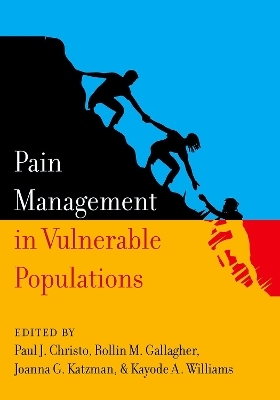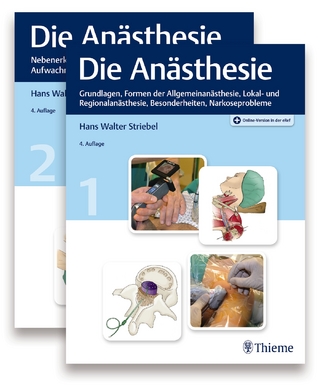
Pain Management in Vulnerable Populations
Oxford University Press Inc (Verlag)
978-0-19-764917-6 (ISBN)
Individual chapters explore conceptual models of vulnerability to pain across the lifespan, beginning in infancy, and in specific clinical populations defined by age, gender, sexual orientation, clinical condition, and healthcare setting. Topics examined range from genomics to sociomedical contexts affecting care such as medical ethics, racial disparities, adverse childhood experiences, disability and workers' compensation, incarceration, torture, military, youth sport, and LGBTQ identity. Challenges to the management of the trajectory of pain are considered in settings ranging from emergency room, palliative and end-of-life care, and nursing homes, prisons, the battlefield, and developing nations. Chapters on illnesses such as sickle cell disease, substance use and mental illness, dental disease, obesity, suicide, HIV, COVID-19, and GI disease discuss personalized treatment plans for each patient's unique needs.
Pain Management in Vulnerable Populations serves as an invaluable resource for pain physicians and will also appeal to primary care physicians as pain is one of the most frequently stated reasons for seeing a primary care physician.
Dr. Christo is an Associate Professor in the Division of Pain Medicine at the Johns Hopkins University School of Medicine where he directed the Multidisciplinary Pain Fellowship Training Program, and the Blaustein Pain Treatment Center. He lectures internationally, serves on journal editorial boards, teaches, co-edited 4 textbooks on pain, and has published over 100 articles and book chapters. He is the author of "Aches and Gains": A Comprehensive Guide to Overcoming Your Pain, hosts "Aches and Gains" an award-winning, national SIRIUS XM radio talk show on overcoming pain, and is a frequent media contributor on pain and addiction. Dr. Gallagher's early academic career (family medicine, psychiatry/behavioral medicine, education deanship, epidemiology) informed decades of research, teaching, clinical care and policy work while developing academic pain programs (Vermont, Stony Brook, Drexel, Penn, VA/DOD) focused on studying clinical trajectories of painful conditions and their biopsychosocial team management, documented in government reports, books, over 200 publications, Editor-in-Chief of Pain Medicine(2000-2020), ACGME Pain Fellowship Committee and AAPM Board(1997-2023[President 2009]). Recent positions: National Director, Pain Management, Veterans Administration; Co-Chair Pain Workgroup, VA/DoD HEC(2010-16); Clinical Professor, Psychiatry/Anesthesiology and Director, Pain Policy Research/Primary Care, UPenn (2004-2018); Co-chair, NIH-IPRCC Education/training Committee(2013-14); Chair, Subcommittee 1, HHS Pain Task Force (2018-19). Dr. Katzman is a neurologist and Professor at the University of New Mexico (UNM). She is Director of the UNM Pain Center and Project ECHO's Public Health programs. In 2008, Dr. Katzman created the Pain and Opioid Management ECHO, which has been replicated by the DoD, the VA, the Indian Health Service, over 145 medical centers, and over 20 countries. She is currently working with the US Centers for Disease Control- Opioid Rapid Response Program. Dr. Katzman's clinical research focuses on the public health benefits of take-home naloxone at both the UNM Pain Center and Addiction and Substance Use Clinic. Dr. Williams is an Associate Professor of Anesthesiology and Pain Medicine and Vice Chair for System Integration and Population Health in the Department of Anesthesiology and Critical Care Medicine, Johns Hopkins School of Medicine. He also holds a joint appointment as Associate Professor at the Johns Hopkins Carey Business School. He has authored and co-authored over 50 publications in his area of research interest, including neuropathic pain, neuromodulation, and healthcare operations management. He serves on the National Institutes of Health (NIH) Neurobiology of Pain and Itch study section, and as President of the American Academy of Pain Medicine 2022-2023.
Section 1: What is a Vulnerable Patient?
Chapter 1: Model of Pain in Vulnerable Populations. What is a Vulnerable Chronic Pain Patient? Social Determinants of Health
Chapter 2: Ethical Considerations in the Context of the Biopsychosocial Model
Chapter 3: Pain Genomics-Defining the Vulnerable Patient
Section 2: The Vulnerable Patient: Pain Throughout the Lifespan
Chapter 4: The Vulnerable Patient: Pain Throughout the Lifespan
Chapter 5: Pain in Infants and Children
Chapter 6: Pain in Older Adults
Chapter 7: Pain in Women
Chapter 8: Pain in LGBTQ
Chapter 9: Pain in the Disabled (and in Worker's Compensation)
Chapter 10: Pain in Patients with Cognitive Impairment (Dementia, Brain Injury, and Developmental Delay)
Chapter 11: Pain among Military Personnel
Chapter 12: Pain at the End-of-Life
Section 3: The Vulnerable Patient: Social Determinants of Pain
Chapter 13: Pain and Adverse Childhood Experiences
Chapter 14: Racial Disparities and Pain- Black, Native American, Latino
Chapter 15: Pain in Patients living in Congregant Settings (Nursing Home, Incarceration, Migrant and Border Settings)
Chapter 16: Pain and Torture: War's Civilian Survivors and Refugees
Chapter 17: Pain in Extreme Situations: The Battlefield and Disasters
Chapter 18: Pain in Developing Nations
Section 4: The Vulnerable Patient: Pain Related to Substance Use, Mental Health, and Suicide
Chapter 19: Pain in Patients with Substance Use Disorders
Chapter 20: Pain and Mental Health (Depression and Anxiety Disorders)
Chapter 21: Pain and Suicide
Chapter 22: Pain in the Seriously Mentally Ill
Section 5: The Vulnerable Patient: Pain Related to Medical Conditions
Chapter 23: Cancer Pain
Chapter 24: Pain in Sickle Cell Disease
Chapter 25: Pain in Chronic GI Disease: Irritable Bowel and Regional Enteritis
Chapter 26: Pain in Patients with HIV
Chapter 27: Pain Related to Thoracic Outlet Syndrome
Chapter 28: Pain Related to Obesity
Chapter 29: Pain and Covid-19
Section 6: The Vulnerable Patient: Management of Pain in Special Circumstances
Chapter 30: Pain and Youth Sports
Chapter 31: Managing Pain in Patients on Long Term Opioids (Surgery and Outpatient)
Chapter 32: Risk of Chronic Pain during Acute, ICU, and Postsurgical Pain
Chapter 33: Pain in ER patients
Chapter 34: Facial and Dental Pain
| Erscheinungsdatum | 09.05.2024 |
|---|---|
| Verlagsort | New York |
| Sprache | englisch |
| Maße | 180 x 257 mm |
| Gewicht | 1021 g |
| Themenwelt | Medizin / Pharmazie ► Medizinische Fachgebiete ► Anästhesie |
| Medizin / Pharmazie ► Medizinische Fachgebiete ► Neurologie | |
| Medizin / Pharmazie ► Medizinische Fachgebiete ► Palliativmedizin | |
| Sozialwissenschaften ► Pädagogik | |
| ISBN-10 | 0-19-764917-3 / 0197649173 |
| ISBN-13 | 978-0-19-764917-6 / 9780197649176 |
| Zustand | Neuware |
| Haben Sie eine Frage zum Produkt? |
aus dem Bereich


